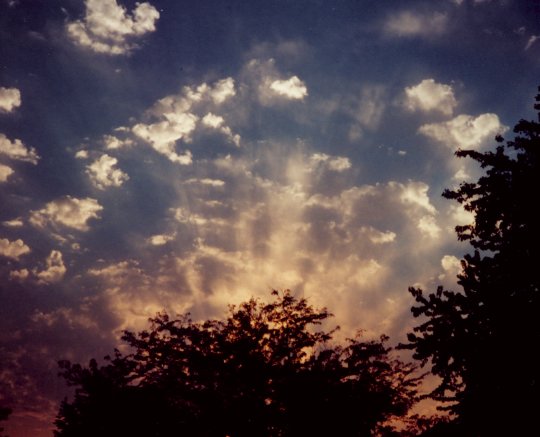SKYLIGHTS

Photo of the Week..Shafts of sunlight shine through
holes between clouds, giving glory to the sky.
Astronomy news for the week starting Friday, February 22, 2002.
The beginning of the week finds the waxing gibbous Moon to the west
of the giant planet Jupiter and approaching its full phase, which
will be reached the night of Tuesday, the 26th, the exact phase
achieved after midnight the morning of the 27th. The Moon passing
through perigee (its closest point to the Earth) on the day of the
full Moon will bring especially high tides to the coast. During
the remainder of the week, our lunar companion will be in its
waning gibbous phase, rising progressively later after sunset.
Last week the Moon occulted Saturn, and now it is Jupiter's turn.
Unfortunately for viewers in the Americas, the event will be
visible mostly in Europe, though Alaska and northern Canada will
get a piece of it. Most will see the Moon pass just a bit to the
north of the planet. The brilliance of Jupiter will make it a fine
sight.
Jupiter, high the North American sky in
Gemini, and Saturn, almost as high in Taurus, dominate the evening. By
the end of the week, Saturn will cross the meridian to the south
almost right at sunset, with Jupiter following about two hours
later. At the same time, look for Mars, which is still hanging in
there for a 10 PM sunset. Then begin to look for Venus, as it
slowly rises out of western twilight. With Saturn setting earlier,
Mars rather constant, and Venus setting later, the three are
heading for a fine rendezvous in early May, when three separate
conjunctions will take place. The morning sky is now bereft of
bright planets. About all that can be said for it is an invisible
conjunction that will take place between Mercury and Neptune, both
in morning twilight, on Sunday, the 24th.
At 8 PM the great Winter Triangle
is in full view to the south. Cutting across three famous
constellations, the Triangle is anchored at the northwest by Betelgeuse in Orion, at the northeast by Procyon of Canis Minor, and at the south by brilliant
Sirius in
Canis Major,
the "Canis" constellations representing Orion's pair
of hunting dogs. Within the triangle lies much of the modern
constellation Monoceros, the
Unicorn, which while in the Milky Way, has few bright stars.
Photographs, however, reveal a number of celestial gems that
include the famous Rosette Nebula and Beta Monocerotis, a stunning triple
star. Orion himself is mostly known by the seven-star figure that
makes his arms, legs, and belt, plus the Sword that contains the
Orion Nebula. But don't ignore the other parts. Up and to the
right of Betelgeuse is Meissa,
which makes his head. Look as well for a string of stars to the
west, called Pi-1 through Pi-6, that represent a skin he is seen
holding in the air.







